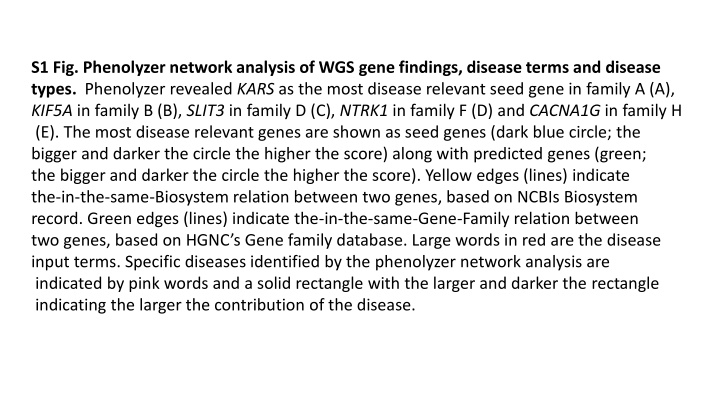
Phenolyzer Network Analysis of WGS Gene Findings and Disease Relevance
Explore the disease relevance of KARS, KIF5A, SLIT3, NTRK1, and CACNA1G in different families through Phenolyzer network analysis. Discover disease input terms and specific diseases identified in the analysis.
Download Presentation

Please find below an Image/Link to download the presentation.
The content on the website is provided AS IS for your information and personal use only. It may not be sold, licensed, or shared on other websites without obtaining consent from the author. If you encounter any issues during the download, it is possible that the publisher has removed the file from their server.
You are allowed to download the files provided on this website for personal or commercial use, subject to the condition that they are used lawfully. All files are the property of their respective owners.
The content on the website is provided AS IS for your information and personal use only. It may not be sold, licensed, or shared on other websites without obtaining consent from the author.
E N D
Presentation Transcript
S1 Fig. Phenolyzer network analysis of WGS gene findings, disease terms and disease types. Phenolyzer revealed KARS as the most disease relevant seed gene in family A (A), KIF5A in family B (B), SLIT3 in family D (C), NTRK1 in family F (D) and CACNA1G in family H (E). The most disease relevant genes are shown as seed genes (dark blue circle; the bigger and darker the circle the higher the score) along with predicted genes (green; the bigger and darker the circle the higher the score). Yellow edges (lines) indicate the-in-the-same-Biosystem relation between two genes, based on NCBIs Biosystem record. Green edges (lines) indicate the-in-the-same-Gene-Family relation between two genes, based on HGNC s Gene family database. Large words in red are the disease input terms. Specific diseases identified by the phenolyzer network analysis are indicated by pink words and a solid rectangle with the larger and darker the rectangle indicating the larger the contribution of the disease.
